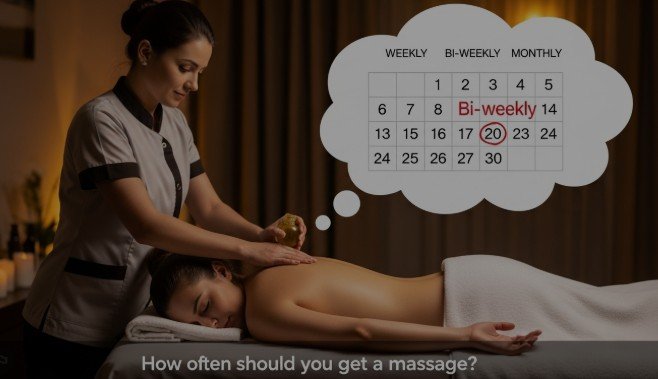If you’re wondering how often should you get a massage, you’re not alone this is one of the most common questions people ask when trying to build a wellness, recovery, or stress-management routine. The ideal frequency isn’t the same for everyone. It depends on your goals, lifestyle, stress levels, and physical needs. This guide breaks down everything you need to know so you can create a massage schedule that genuinely supports your body.
Most people benefit from a massage every 1–4 weeks, depending on their goals.
For stress relief, weekly or bi-weekly sessions work well. For chronic pain, injury recovery, or athletic support, weekly appointments may be ideal. For general wellness, a monthly massage is usually enough.
Ultimately, the right frequency depends on what you want to achieve and how your body responds.
Understanding How Massage Frequency Impacts Your Body
How Massage Works on Muscles, Fascia, and Circulation
Massage improves blood flow, loosens tight muscles, releases fascia (the connective tissue), and promotes nutrient delivery to tissues. These benefits fade over time, which is why consistent sessions improve results.
The Role of Stress Levels and Lifestyle
If your daily life includes long periods of sitting, poor posture, high activity, or chronic stress, your body accumulates tension faster meaning you may need massages more often.
The Difference Between Maintenance vs. Treatment Plans
- Maintenance: Once your body is relatively balanced, you can switch to bi-weekly or monthly sessions.
- Treatment: For acute pain, injury, or heavy stress, frequent weekly sessions may be necessary.
How Long Massage Benefits Typically Last
The effects of massage last anywhere from 3 days to 3 weeks. Pain relief and stress reduction naturally diminish, which helps determine how often you need the next session.
How Often Should You Get a Massage (Detailed Breakdown)
How Often Should You Get a Massage Based on Your Goals
For Stress Relief
Weekly or bi-weekly helps regulate cortisol levels and maintain emotional balance.
For Chronic Pain or Tension
Weekly deep tissue or trigger point work is recommended until symptoms decrease.
For Athletes and High-Activity Lifestyles
1–2 sessions per week support performance, mobility, and faster recovery.
For Injury Recovery or Rehabilitation
Weekly targeted therapy helps tissue repair, reduces inflammation, and improves mobility.
For Posture Improvement and Desk-Related Pain
Bi-weekly or weekly sessions counteract muscle imbalance and stiffness.
For Lymphatic Support or Detox-Style Massage
Weekly lymphatic drainage encourages fluid movement and reduces swelling.
For Pregnancy Massage (Prenatal Considerations)
Every 2–4 weeks is typical, but frequency varies by trimester, comfort level, and medical guidance.
People Also Ask: Common Questions About Massage Frequency
Is It OK to Get a Massage Every Week?
Yes. Many people, especially those with high stress or chronic tension, benefit from weekly sessions.
Can You Get Too Many Massages?
It’s possible if your body becomes overly sensitive, bruised, or fatigued. Moderation and proper hydration help prevent this.
How Long Should You Wait Between Deep Tissue Massages?
Typically 7–10 days. Deep tissue work requires recovery time.
Does Massage Work Better With Regular Sessions?
Absolutely. Massage benefits compound over time similar to exercise or physical therapy.
How Often Should Athletes Get Massages?
1–2 times weekly during training seasons, and bi-weekly during off-season.
What Happens If You Only Get a Massage Occasionally?
You’ll experience short-term relief but won’t fix chronic issues or maintain long-term results.
Step-by-Step Guide: How to Determine Your Ideal Massage Frequency
Step 1: Identify Your Primary Goal
Pain relief? Stress reduction? Flexibility? Your goal determines your schedule.
Step 2: Evaluate Your Pain or Stress Levels
More tension requires more frequent sessions.
Step 3: Consider Your Budget and Schedule
Choose a frequency that feels sustainable consistency matters more than intensity.
Step 4: Choose the Right Type of Massage for Your Needs
Sports, deep tissue, lymphatic, Swedish each supports different goals.
Step 5: Track Your Progress After Each Session
Note soreness levels, pain changes, sleep quality, and mood.
Step 6: Adjust Frequency Based on Results
Increase sessions if pain returns quickly; decrease them once symptoms stabilize.
Massage Frequency Recommendations by Situation
| Category | Recommended Frequency | Ideal Massage Type | Why This Frequency Works |
|---|---|---|---|
| Stress Relief | Weekly or bi-weekly | Swedish, relaxation | Maintains emotional and physical calm |
| Chronic Pain | Weekly | Deep tissue, trigger point | Supports muscle recovery & pain management |
| Athletes | 1–2x weekly | Sports, deep tissue | Enhances performance & recovery |
| Desk Workers | Bi-weekly | Deep tissue, myofascial | Counteracts posture strain |
| Injury Recovery | 1–2x weekly | Targeted therapy | Improves healing & mobility |
| Lymphatic Support | Weekly | Lymphatic drainage | Encourages fluid movement |
| General Wellness | Monthly | Any preferred type | Maintenance for long-term health |
Safety Considerations Before Increasing Massage Frequency
When Frequent Massage Is Beneficial
If you’re dealing with chronic pain, heavy training, or high stress, weekly sessions may be ideal.
When to Reduce or Pause Massage Sessions
Stop or reduce frequency if you experience:
- Excessive soreness
- Bruising
- Fatigue
- Joint or nerve pain
Health Conditions That Require Caution
Massage may require medical clearance if you have:
- Blood clot risks
- Severe inflammation
- Pregnancy complications
- High fever or infection
Understanding Pressure Levels and Your Body’s Limits
More pressure doesn’t always equal better results. Always communicate with your therapist.
Signs You’re Overdoing Your Massage Routine
- Lingering soreness
- Feeling drained instead of refreshed
- Sensitivity to touch
- Reduced performance
FAQs About Massage Frequency
1. How often should you get a massage for stress?
Weekly or bi-weekly sessions work best for managing stress levels.
2. Is weekly massage too much?
Not for most people especially those with chronic stress, pain, or athletic needs.
3. How often should you get a massage if you work at a desk?
Every 2 weeks helps counteract posture-related tension.
4. How soon after deep tissue massage can you get another?
Typically after 7–10 days.
5. Can regular massage improve long-term posture?
Yes. Routine sessions help correct muscular imbalances.
6. How often should you get a massage if you have chronic back pain?
Weekly sessions are ideal until symptoms improve.
7. Does getting frequent massages have side effects?
Only if you overdo it moderation and communication prevent issues.
8. What’s the ideal frequency for massage on a budget?
Monthly maintenance sessions still offer strong benefits.
Conclusion: Finding the Massage Frequency That Truly Works for You
When deciding how often should you get a massage, focus on your personal goals, current physical condition, and lifestyle demands. Consistency creates more lasting results than occasional sessions. Whether you’re managing stress, recovering from injury, improving posture, or maintaining overall wellness, your ideal frequency should support not overwhelm your body.
Listen to how you feel after each session, adjust as needed, and build a routine that truly enhances your long-term wellbeing.







